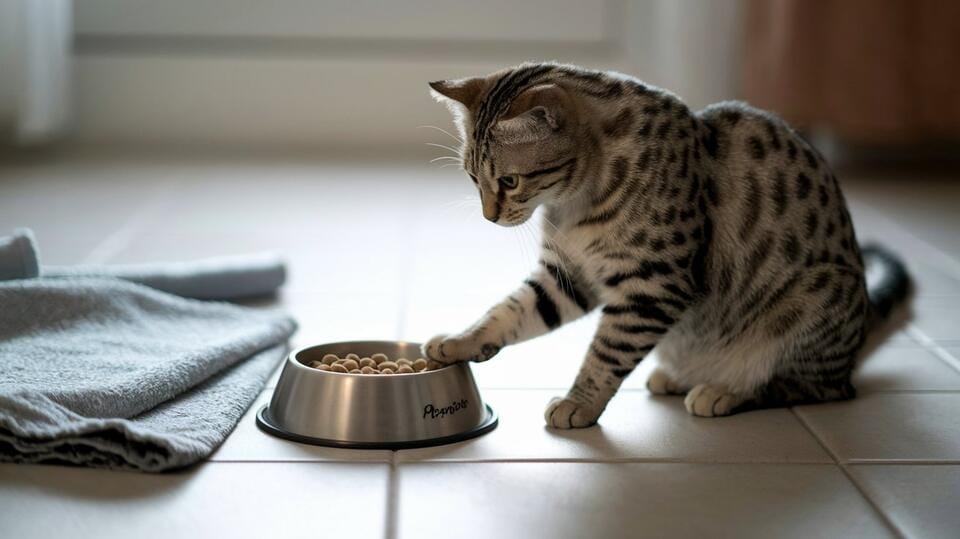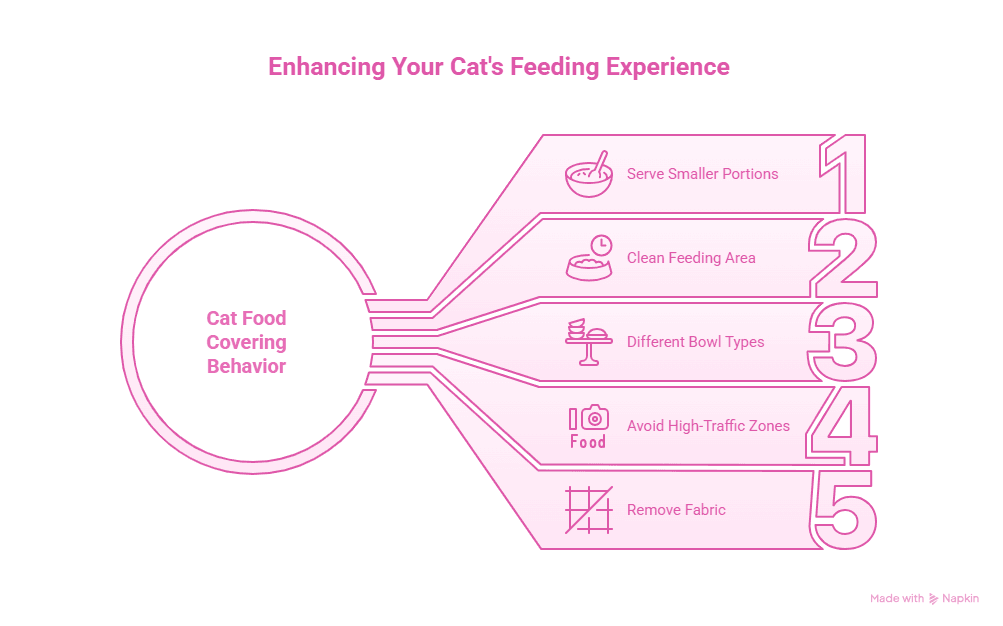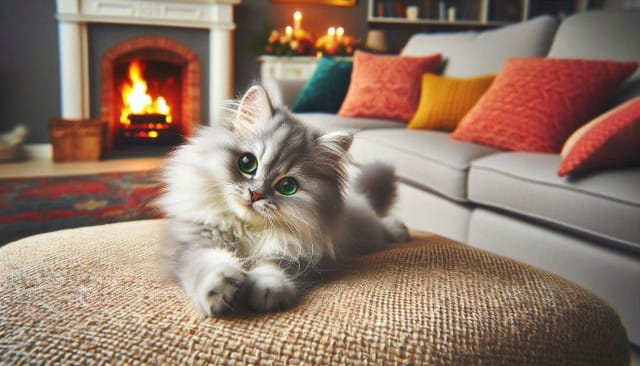
Introduction
Ever watched your cat finish (or ignore) their meal, only to see them pawing at the floor or attempting to drag a towel, newspaper, or imaginary “cover” over their food bowl?
It might seem quirky or even comical, but this behavior isn’t random.
In fact, it’s a deeply ingrained instinct that goes back thousands of years.
So, why do cats cover their food?
Is it a sign of hunger, anxiety, dominance, or just plain weirdness?
In this article, we’ll uncover the reasons behind this fascinating behavior, from survival instincts and territorial habits to emotional triggers and modern environmental cues. Whether your cat is an occasional paw-scraper or a full-blown food hoarder, you’ll walk away understanding what’s really going on—and what, if anything, you should do about it.
What Does It Mean When a Cat Covers Their Food?
Let’s start with the behavior itself.
When a cat “covers” their food, it typically looks like:
- Pawing or scratching at the floor near the bowl
- Attempting to drag nearby fabric, paper, or rugs over the bowl
- Repeated motions without actually touching the food
Some cats do this before they eat. Others do it after. Some never do it at all.
Regardless of how or when it happens, this behavior is part of a group of actions known as “food caching” or “food burying.”
In nature, this is not unusual, and your housecat is just expressing ancient survival tactics, even if they’re dining on canned pâté in a climate-controlled kitchen.
Instinct #1: Saving Leftovers for Later (Caching Behavior)
In the wild, many feline species—including big cats—engage in food caching.
They bury leftovers or cover them with debris to:
- Prevent spoilage
- Keep scavengers or rivals from finding it
- Return to it later when they’re hungry again
Domestic cats have evolved from wild ancestors like the African wildcat, which often cached uneaten prey for safety and later consumption.
So, if your cat:
- Doesn’t finish a meal
- Is full but doesn’t want to “waste” food
- Lives in a multi-cat household with competition
…their instinct may kick in to “protect” their stash by trying to cover it—even if there’s no dirt or leaves around to do so.
Instinct #2: Hiding Scent from Predators or Rivals
Cats are scent-driven animals. In the wild, leftover food smells could attract:
- Predators
- Rival carnivores
- Insects or scavengers
By covering food, cats aim to mask the smell and reduce risks.
Even though your indoor cat isn’t fending off coyotes in your kitchen, their brain still says:
“Better hide the leftovers. Something might come for me.”
This survival behavior is especially strong in:
- Timid or anxious cats
- Cats from feral backgrounds
- Cats in homes with dogs, children, or frequent guests
Instinct #3: Avoiding Conflict With Other Pets
In multi-pet households, food isn’t just food—it’s a territorial resource.
Some cats cover their food to avoid:
- Starting a fight with a dominant sibling
- Drawing attention from a nearby dog
- Losing access to their bowl altogether
It’s their way of saying:
“I’m not done yet, but I don’t want to fight about it. I’ll just save this for later.”
Interestingly, some dominant cats will cover food that’s not even theirs, to claim it or “block” access for others.
Environmental Influences: When Cats Adapt Their Behavior Indoors
Let’s face it—your home doesn’t exactly mimic the savannah.
Still, indoor cats find ways to act on their instincts using whatever’s around.
🧻 Common “covering” methods include:
- Pawing the floor like they’re digging
- Trying to use nearby rugs or mats
- Pulling over newspapers or even toy mice
- Scratching at tile or laminate surfaces (with no actual result)
This is especially common if:
- You feed them on soft surfaces (rugs, cloth mats)
- You leave uneaten food out for hours
- Their feeding area feels exposed or stressful
Even if there’s nothing to physically cover the food, your cat may go through the motions. To them, the gesture is enough, kind of like how kneading doesn’t need milk to be comforting.
Is It Normal? Or Should You Be Concerned?
For the most part, yes—it’s normal.
Food-covering behavior is:
- Harmless
- Instinctual
- Often quirky and amusing
However, like any behavior, context matters. If your cat is obsessively trying to cover food or avoids eating altogether, it could point to a problem.
🚩 Potential issues to watch for:
- Disinterest in food = they don’t like it, or feel unwell
- Frantic covering or pawing = stress, anxiety, or a sense of threat
- Covering in clean environments = scent sensitivity or dislike of bowl material
- Covering followed by vomiting = possible GI issues or allergies
If your cat suddenly starts covering food after years of not doing it, consider a vet check-up to rule out dental pain, nausea, or stress-related conditions.
Why Some Cats Cover Their Food and Others Don’t
Just like humans have different habits around meals, so do cats.
You might wonder:
“Why does only one of my cats do this?”
It often depends on:
- Personality: Cautious or submissive cats are more likely to cover
- Early life experience: Cats from shelters or feral backgrounds may retain stronger survival habits
- Feeding environment: If their bowl is near a noisy appliance or in a high-traffic area, they may feel the need to protect their food
- Competition: More likely in multi-pet homes
Some cats are just more ritualistic. Others are food-focused but confident. There’s no “right” way.
Can This Behavior Be Learned from Other Pets?
Absolutely.
Cats are observant, and in multi-cat homes, they may imitate each other’s behavior, especially if one cat consistently covers food and doesn’t experience consequences.
Also, dogs often bury bones or hide treats, and some cats will mimic this behavior out of curiosity or competition.
So yes, your cat might be copying their canine sibling’s weird hoarding habits!
What Should You Do If Your Cat Covers Their Food?

In most cases, nothing. It’s harmless and kind of cute.
But if it becomes messy, disruptive, or signals discomfort, try the following:
✅ Practical Tips:
- Serve smaller portions to reduce leftovers
- Use a clean, flat feeding area (away from litter boxes and water bowls)
- Try a different bowl—ceramic, glass, or shallow designs can reduce whisker fatigue
- Place food away from high-traffic zones
- Avoid fabric near feeding spots if they’re dragging things over the bowl
If your cat tries to bury uneaten food multiple times a day, consider switching to scheduled feeding instead of free-feeding. This can reduce both food waste and anxious behavior.
When Covering Becomes a Problem: Behavioral Red Flags
Covering food is usually harmless, but it can also be a coping mechanism for deeper issues like:
- Stress from environmental change (new pets, guests, moving)
- Feeding area insecurity (noisy, crowded, or too exposed)
- Undiagnosed health issues
- Lack of routine or excessive boredom
If your cat begins:
- Covering food aggressively
- Avoiding meals
- Exhibiting other anxious behaviors (hiding, over-grooming, excessive meowing)
…it’s time to reassess their physical and emotional environment—and consult your vet if needed.
FAQs
Why does my cat pretend to bury their food on hardwood floors?
It’s instinct! Even if there’s nothing to actually bury it with, the action helps them feel like they’re protecting their food. Scratching or pawing is the equivalent of “going through the motions.”
Is it bad if my cat never tries to cover their food?
Not at all! Many confident, food-motivated, or socially dominant cats don’t feel the need to hide or save food. That’s perfectly normal, too.
Why does my cat only do this with wet food, not dry?
Wet food has a stronger smell, making it more likely to trigger scent-related instincts. Dry food may not register the same way to their survival brain.
Should I stop my cat from doing this?
No need to stop it unless it causes a mess or stress. It’s instinctual and not harmful. Simply manage the environment if it becomes inconvenient.
Is this related to food aggression?
Usually, no. Food covering is about protection or future use, not aggression. But if your cat growls, guards, or lashes out during mealtime, that’s a separate issue to address.
Also Read - Why Do Cats Love Sunbathing? The Cozy Science Behind Feline Sun Worship
Conclusion
So, why do cats cover their food?
Because even in the comfort of our homes, our feline friends are still guided by ancient instincts.
Whether it’s about protecting leftovers, hiding their scent, or just reacting to household stress, this behavior is a natural part of your cat’s toolkit for survival—even if it seems out of place in your kitchen.
Unless it’s excessive or signals deeper issues, there’s nothing to worry about. In fact, it’s just another reminder of how wonderfully wild and wise your cat still is—even after all these years of domestication.
So the next time your kitty scratches at the floor after dinner or tries to bury their bowl under a towel, smile a little.
You’re witnessing the echo of the wild—and the comfort of instinct.




